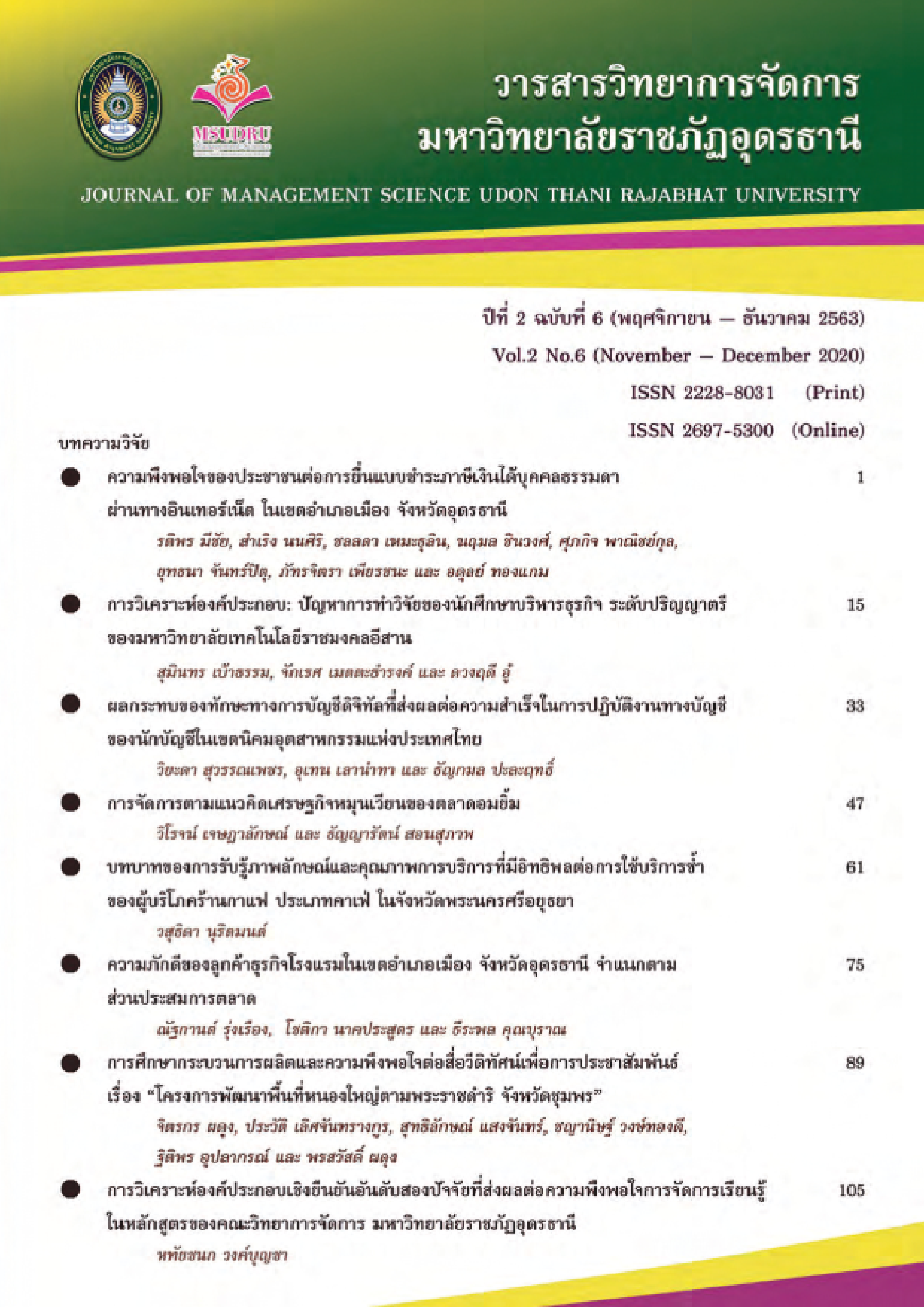THE LOYALTY OF HOTEL BUSINESS CUSTOMER IN THE DOWNTOWN OF UDONTHANI PROVINCE VIA DISCRIMINANT ANALYSIS CATEGORIES OF MARKET MIX
Main Article Content
Abstract
The purpose of this research is to study the marketing mix theory that crucial for discriminant analysis of customer’s loyalty and establish the discriminant method of customer’s loyalty to stay in the hotel, particularly in the downtown of Udonthani Province context. Population in this research was customer staying in the 3-star hotels located in downtown of Udonthani Province. Which launched about 25 hotels between June until July in 2020 and the number of popularity is unknown. The sample group consisted of 266 tourists staying at Ruay-Suk Hotel and Ruay-Suk and Swimming Pool. The Sample size determination conducted through the parameter estimation, and Cluster Sampling. The instruments for data collection included Five-point-rating scale questionnaires. The discriminant index ranged from 0.224 to 0.648, the test illustrated the reliability of 0.879. The data analysis was by Discriminant Analysis, and the results of the research can be described as follows; There were positive relationships between the elements among the customer’s loyalty in-term of the marketing- mix. The physical characteristic is the most crucial to generating customer’s loyalty, and correlation about 0.861, as follows; channel of distribution, product, and price with correlation about -0.634, and -0.543, respectively. The discriminant method of customer’s loyalty in term of marketing mix showed the two elements of loyalty (Loyalty and disloyalty) with a significant level of .01. The per cent of explained variance about loyalty was 36.5 and forecasted precisely about 81.20 %. The discriminant function in a Standardized Score as Following; Z= -.634X1 - .543X2 + .721X3 + .092X4 - .141X5 - .079X6 + .861X7
Article Details

This work is licensed under a Creative Commons Attribution-NonCommercial-NoDerivatives 4.0 International License.
บทความที่ได้รับการตีพิมพ์เป็นลิขสิทธิ์ของคณะวิทยาการจัดการ มหาวิทยาลัยราชภัฏอุดรธานี
ข้อความที่ปรากฏในบทความแต่ละเรื่องในวารสารวิชาการเล่มนี้ ไม่ใช่ความคิดเห็นและความรับผิดชอบของผู้จัดทำ บรรณาธิการ กองบรรณาธิการ และคณะวิทยาการจัดการ มหาวิทยาลัยราชภัฏอุดรธานี ความรับผิดชอบด้านเนื้อหาและการตรวจร่างบทความแต่ละเรื่องเป็นความคิดเห็นของผู้เขียนบทความแต่ละท่าน
References
กระทรวงการท่องเที่ยวและกีฬา. (2561). สถิติด้านการท่องเที่ยว. สืบค้นเมื่อ 19 กุมภาพันธ์ 2563, จาก https://www.mots.go.th/more_news_new.php?cid=497กรุงเทพฯ:สถาบันTDRM
การะเกด แก้วมรกต. (2554). ปัจจัยส่วนประสมทางการตลาดที่มีผลต่อการเลือกใช้บริการโรงแรม ของนักท่องเที่ยวชาวไทยในจังหวัดกระบี่. วิทยานิพนธ์ปริญญาบริหารธุรกิจมหาบัณฑิต, มหาวิทยาลัยราชภัฏสุราษฎร์ธานี.
ไทยรัฐออนไลน์. (2561). การจัดงานโมโตจีพี. สืบค้นเมื่อ 12 ตุลาคม 2561, จาก https://www.thairath.co.th/content/1392880
วริศรา วาริชวัฒนะ และกุลเชษฐ์ มงคล. (2556). ปัจจัยที่มีผลต่อพฤติกรรมการเลือกที่พักแรมใน อำเภอหัวหิน จังหวัดประจวบคีรีขันธ์ ของนักท่องเที่ยวที่อาศัยอยู่ในกรุงเทพมหานคร. วารสารวิทยาลัยบัณฑิตศึกษาการจัดการ มหาวิทยาลัยขอนแก่น, 6(2).
ศิมาภรณ์ สิทธิชัย และสิญาธร ขุนอ่อน (2558). การวัดความภักดีของลูกค้าสำหรับธุรกิจโรงแรม.วารสารนักบริหาร. 35(1), 64-74.
สิริทิพย์ ฉลอง. (2560). ธุรกิจโรงแรม. หน่วยวิเคราะห์เศรษฐกิจภาคบริการ ส่วนเศรษฐกิจรายสาขา ศูนย์วิจัยเศรษฐกิจ ธุรกิจและเศรษฐกิจฐานราก การวิจัยธนาคารออมสิน.
สุดาดวง เรืองรุจิระ. (2557). หลักการตลาด. พิมพ์ครั้งที่ 9. กรุงเทพฯ: สำหนักพิมพ์ยงพลเทรดดิ้ง.
ศุภกฤต ปิติพัฒน์. (2561). ตัวแบบความสัมพันธ์เชิงสาเหตุความเป็ยเมืองน่าอยู่ในภาคตะวันออกเฉียงเหนือตอนบน. วารสารปัญญาภิวัฒน์, 10(1).
Aaker, D. A. (1991). Managing brand equity: Capitalizing on the value of a brandname. New York, NY: The free press.
Dunn, D. (1997). Relationship marketing: A 35 minute primer. Frequency marketing Strategies, strategic research Institute. Omni Chicago: Chicago.
Ivanauskiene, N., & Auruskevicien, V. (2009). Loyalty programs challenges in retail banking industry. Economics & Management, 14, 407-412.
Oliver, R. L. (1997). Satisfaction: A behavioral perspective on the consumer. Boston MA: Irwin/McGraw-Hill.
Skogland, I., & Siguaw, J. A. (2004). Are your satisfi ed customers loyal. Cornell Hotel and Restaurant Administration Quarterly, 45(3), 221-234
Shoemaker, S., & Lewis, R.C. (1999). Customer loyalty: The future of hospitality marketing. International Journal of Hospitality Management, 18(4), 345–370.
Srivastava, R. K., Shervani, T. A., & Fahey, L. (2000). Market-based assets and shareholder value: A framework for analysis. Journal of Marketing, 62(1), 2–18.
Tanforda, S., Raabb, C., & Kimb, Y. S. (2012). Determinants of customer loyalty and purchasing behavior for full-service and limited-service hotels. International Journal of Hospitality Management, 31, 319–328.

